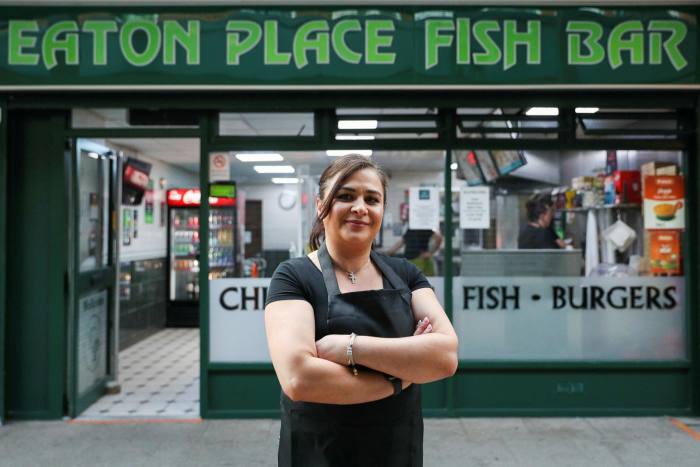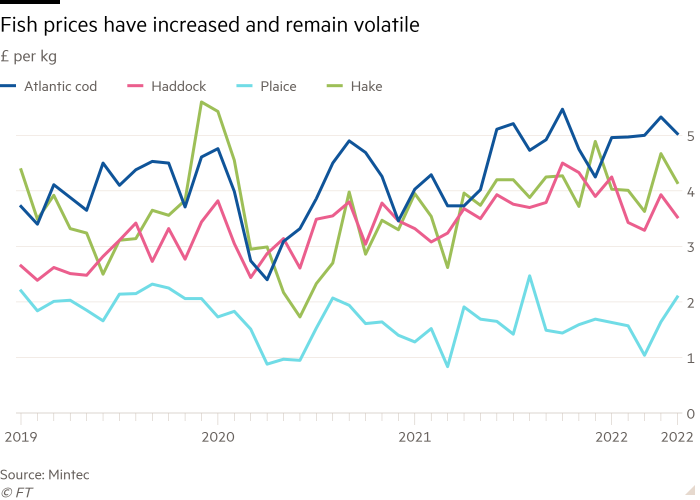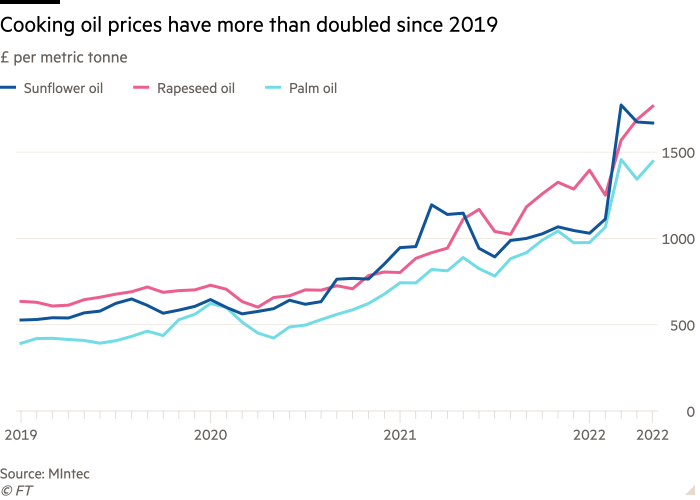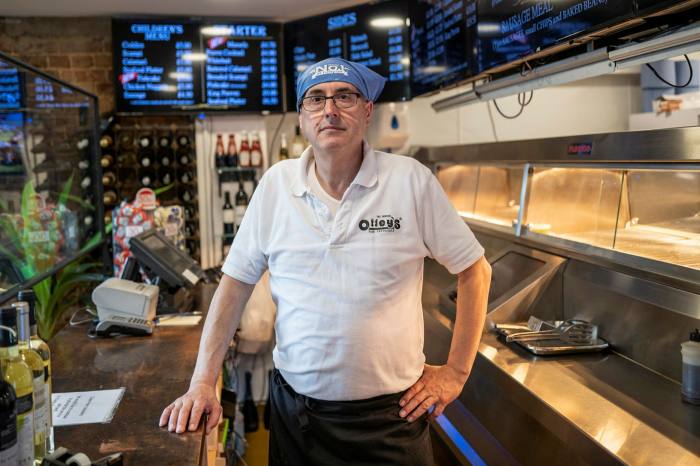UK fish and chip shops are branching out into lesser-known species, such as hake or sea trout, and offering smaller portions, as the rising price of often Russian-caught fish pushes makers of the classic British meal to the point of closure.
The usually family-run businesses, which prospered as households turned to takeaways during Covid-19 lockdowns, are now grappling with surging energy prices and labour shortages alongside higher costs for ingredients.
The situation has turned many shops — which operate on wafer-thin margins — into close watchers of the war in Ukraine that has hit supplies of vital ingredients, including white fish and cooking oils.
“All of [the costs are going up], every single last one. Normally potatoes go up at a certain time of year and come down again, and the same with fish . . . But this is unprecedented,” said Elena Georgiou, owner of Eaton Place Fish Bar in Nottingham, in England’s East Midlands.
Georgiou has already increased the price of a portion of haddock by 20 per cent to £6.90 and is barely breaking even. “I have never known so many fish and chip shops go up for sale,” she said.

Meanwhile, Mitch Tonks, owner of Rockfish seafood restaurants, warned that the mainstream fish and chip industry “will be really challenged”. “The chippy on a Friday night will no longer be cheap eats,” he said.
Fish and chip shops flourished during the coronavirus pandemic as restrictions on dining out favoured takeaways. In England, their numbers have grown by 11.6 per cent to more than 6,900 since the start of 2020, according to the Local Data Company.
But the pressures are mounting. Fish and chipmakers are once again being charged full VAT, which returned in April after a reduction during the pandemic, while facing fresh competition with the expansion of fast-food chains such as McDonald’s and Wendy’s.
On top of this, input costs are reaching all-time highs as fish and chip shops rely on products that are among the most affected by Russia’s invasion of Ukraine.
Much of the cod and haddock sold in chippies is caught by Russian vessels now threatened with a 35 per cent tariff by the UK, while prices for those fish have already surged because of a poor catch and US levies on Russian products. Prices for whole Atlantic cod in the UK market rose 26 per cent in one week to May 9 to €5.49 a kilo, according to the Globefish database. The effect on the price of fillets bought by fish and chip shops has been severe.

Andrew Crook, president of the National Federation of Fish Friers and owner of a fish and chip shop north of Manchester, said he had struggled to find 32oz cod fillets, which were selling at £270 a case, up from £140 a case last year. “We have undersold our product for a long time. People think it should be cheap,” he added.
Aoife Martin, director of operations at Seafish, a public body supporting the seafood industry, said that 35 to 45 per cent of white fish consumed in the UK was Russian-caught. “Fish and chip shops are significant importers of frozen-at-sea fillets directly from the Russian fleet in the Barents Sea,” she noted.
Russian-caught cod and haddock also arrive via China, though this would likely escape the new UK tariff because it had “substantive processing” in a third country.
Gary Warner, managing director at Warners Fish Merchants, said yields had started to decline late last year, even before war broke out in February, partly owing to a cut in fishing quotas by Norwegian and Russian authorities. “In the Russian-origin area, the decrease in catch has been dramatic. Last September we saw a very big drop-off,” he said
In response to the supply squeeze and rising prices, family shops have been diversifying but are coming up against consumers with conservative tastes.
“I’ve been trying hake from South Africa on the menu at a slightly lower price. I’ve also put farmed sea bream on above cod and haddock . . . but you don’t sell a lot of them. People tend to know what they want when they come [in],” said Crook.
The Q Partnership, a group of three longstanding fish and chip shop suppliers, has developed a smaller and cheaper “light bites” fish and chips package.

Besides fish prices, costs for cooking oil, another ingredient, have shot up, particularly since Ukraine is a major sunflower producer. Wholesale prices for sunflower oil have increased more than 150 per cent since the start of 2020, according to Mintec data, reaching £1,668 a tonne. That has especially hurt chip shops that in recent years have converted to high oleic sunflower oil, a variant well-suited to frying.
An initial “oil panic” as the war began has calmed, and some sunflower products are managing to leave Ukraine via its land borders, said Adam Baisley, chief commercial officer at oil supplier Olleco.
But the scarcity of sunflower oil had pushed up prices for other fats, said Gary Lewis, head of business development at KTC Oils and Fats, including palm oil, used chiefly in the north-east and on the east coast. Beef dripping, favoured in traditional mining cities, Scotland and Northern Ireland, has risen in price because of staff shortages in abattoirs.

Some fish and chip shops were reducing their frying hours and looking for ways to filter oil to make it last longer, said Lewis. Prices for wheat used in batter have also increased, while a fertiliser shortage is expected to push up the cost of potatoes for chips.
Harry Niazi, who runs Olley’s Fish Experience in Herne Hill, south London, said he had been unable to get haddock for 10 days over Easter. “Normally it’s a cycle, but I have a terrible feeling that the price of fish, the price of oil, the price of potatoes will stay high for at least a year and we will just have to deal with it.”
In Nottingham, Georgiou is looking through her orders and changing suppliers if she can save even £1. Even salt prices have risen. “We are doing our utmost best to stay open,” she said.

